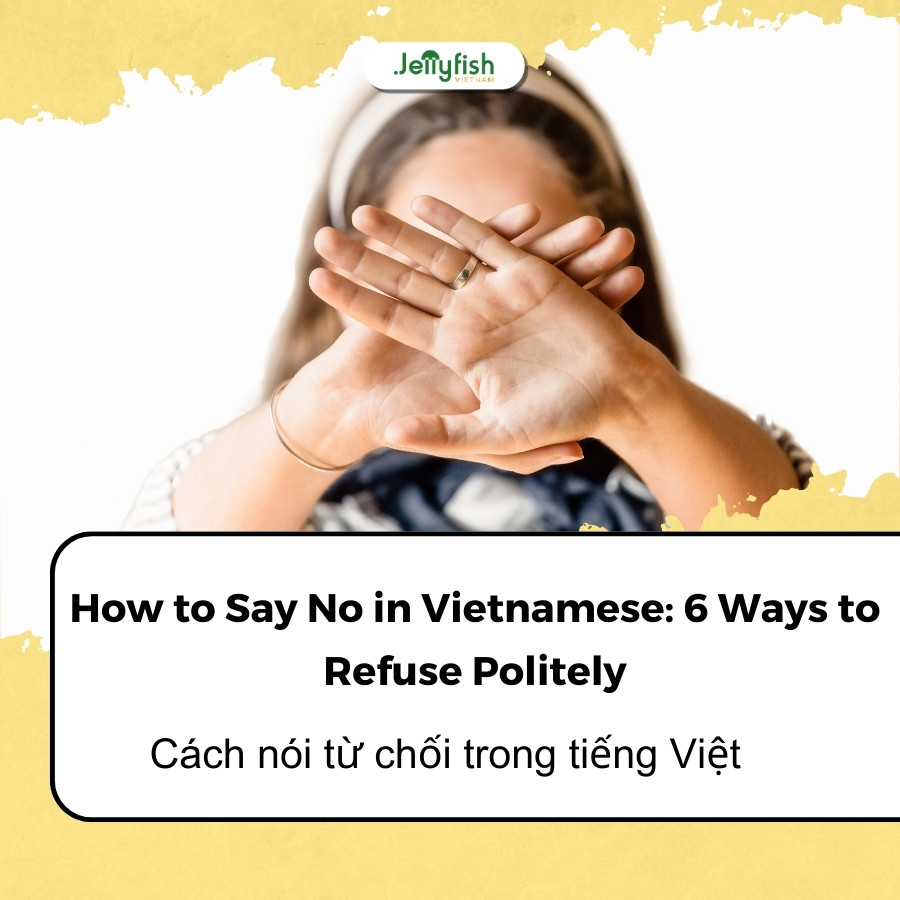Saying “no” can be difficult — especially in a culture that values harmony like Vietnam. Whether you’re turning down an offer, declining help, or expressing disagreement, it’s important to do so with the right words and tone. In this guide, Jellyfish explains how to say no in Vietnamese with expressions that are polite, respectful, and culturally appropriate.
1. The Basic Word for “No” in Vietnamese
Không – [Pronounced: khong (low tone)]
This is the direct translation of “no” in Vietnamese. It’s short, clear, and neutral.
Examples:
- Không, cảm ơn. → No, thank you.
- Không được. → Not allowed / You can’t.
- Không sao đâu. → No problem / It’s okay.
While không is simple, it’s rarely used alone in social situations — usually followed by softening or polite phrases.
2. How to Politely Say No in Vietnamese
To keep the conversation friendly, especially with elders, teachers, or in business, use these polite refusals:
- Xin lỗi, tôi không thể. → Sorry, I can’t.
- Tôi e là không được. → I’m afraid I can’t.
- Cảm ơn, nhưng tôi phải từ chối. → Thank you, but I have to decline.
- Rất tiếc, tôi không tham gia được. → I’m really sorry, I can’t join.
These soften the impact of “no” and are essential for understanding how to say no in Vietnamese gracefully.
3. Saying No Indirectly (Common in Vietnamese Culture)
In Vietnam, people often avoid saying “no” directly to maintain politeness. Here are some indirect refusals that locals commonly use:
- Để em xem đã nhé. → Let me think about it first. (Often a gentle “no”)
- Chắc là khó quá. → That might be too difficult.
- Lúc khác nhé. → Maybe another time.
- Em chưa chắc đâu. → I’m not sure yet. (likely a “no”)
Learning these phrases helps you say no in Vietnamese without sounding too blunt or offensive.
4. Saying No to Invitations or Offers
When someone invites you to dinner, a party, or a meeting, it’s important to refuse with appreciation.
Try these:
- Cảm ơn anh, nhưng hôm đó em bận rồi. → Thank you, but I’m busy that day.
- Rất tiếc, em có việc đột xuất. → Sorry, something came up.
- Cảm ơn lời mời, nhưng em không thể tham gia. → Thank you for the invitation, but I can’t join.
Cultural tip: You can still show gratitude even when declining — it builds good relationships.
5. Saying No at Work or School
In professional or academic settings, showing respect while being honest is key.
Use:
- Tôi e là dự án này không phù hợp với nhóm của tôi.
→ I’m afraid this project doesn’t fit my team. - Em xin phép không tham gia vì lý do cá nhân.
→ I’d like to be excused for personal reasons.
This helps you say no in Vietnamese in formal situations without offending anyone.
6. How to say no in a friendly way

When talking to friends or people your age, you can be more casual:
- Thôi, không nha. → No, thanks.
- Tớ không thích lắm. → I don’t really like it.
- Khỏi đi! → Don’t bother! (friendly refusal)
- Không được đâu! → That won’t work! (light, playful tone)
Tone is very important let keep it cheerful to avoid sounding too serious.
7. Summary Table: How to Say No in Vietnamese
| Vietnamese Phrase | Meaning | Use Case |
| Không | No | Neutral, basic |
| Không, cảm ơn | No, thank you | Polite, general |
| Xin lỗi, tôi không thể | Sorry, I can’t | Polite refusal |
| Chắc là khó quá | That might be too difficult | Indirect, soft rejection |
| Lúc khác nhé | Maybe another time | Friendly, flexible |
| Em chưa chắc đâu | I’m not sure yet | Casual “no” |
| Rất tiếc, tôi không tham gia được | Sorry, I can’t join | Declining invitations |
| Không được đâu! | No way! / That won’t work | Friendly, joking context |
Conclusion
Now that you know how to say no in Vietnamese, you can respond with clarity and kindness in any situation. Whether you need to refuse politely, casually, or indirectly, these phrases will help you maintain respect and confidence in conversations.
Practice Saying No Politely with Jellyfish
At Jellyfish, we teach you more than just grammar — we help you express yourself like a native speaker.
- Learn how to say no in Vietnamese naturally
- Practice polite responses for work, school, and daily life
- Get comfortable with tone, body language, and pronunciation
👉👉 Learning Vietnamese – Jellyfish Vietnam
✦ Hotline: 096 110 6466
✦ Head office: 1st Floor, Web3 Tower Building, Alley 4 Duy Tan Street, Cau Giay District, Hanoi
✦ Branch office: Sholega building, 275 Lach Tray, Ngo Quyen, Hai Phong
✦ Head office in Japan: 4F Westhill Building, Nishigotanda 2-24-4, Shinagawa, Tokyo, Japan


